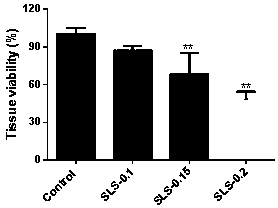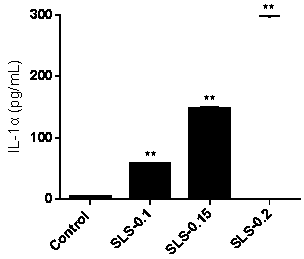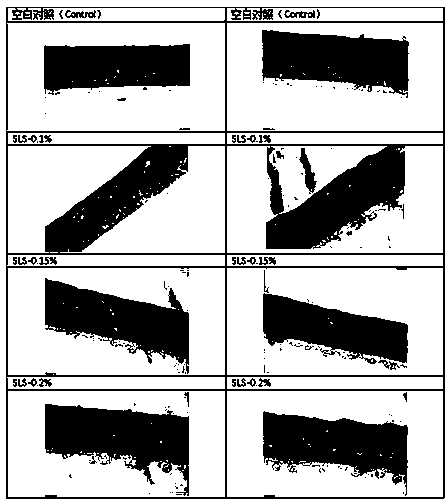Construction method of diaper dermatitis-like in-vitro recombinant epidermis model
A technology for diaper dermatitis and a construction method, applied in the field of tissue engineering, can solve the problems of lack of diaper-like dermatitis, insufficient accuracy, etc., and achieve the effects of shortening modeling time, reducing individual differences, and avoiding species differences
- Summary
- Abstract
- Description
- Claims
- Application Information
AI Technical Summary
Problems solved by technology
Method used
Image
Examples
Embodiment 1
[0037] Example 1: Construction method of the recombinant epidermal model of diaper-like dermatitis
[0038] Step 1. Preparation of Epidermal Cells
[0039] Take primary keratinocytes, recover and expand, use P7 cells, digest with 2.5% trypsin (100 mL PBS, 2.5 g trypsin) digestion solution, use MCDB153 medium to make single cell suspension, follow the 2.5× 10 5 Individual / mL density, inoculated in culture flasks, placed at 37°C, 5% CO 2 cultivated under conditions.
[0040] Step 2, submerged culture of epidermal cells
[0041] Take the cells in the logarithmic growth phase, and use cell culture medium I to make the cell density 2.5×10 6 cells / mL of epidermal cell suspension, inoculate 200 μL into a cell culture chamber containing a polycarbonate filter membrane, and place at 37°C, 5% CO 2 Cultivate under these conditions for 2 hours; then place the small chamber in a model petri dish, add 70 mL of cell culture medium I to each dish, and store at 37°C, 5% CO 2 The culture ...
Embodiment 2
[0067] Example 2: Construction of an in vitro recombinant epidermal model of diaper-like dermatitis
[0068] Step 1. Preparation of Epidermal Cells
[0069] Take the primary keratinocytes, after recovery and expansion, use the P7 generation cells, digest with 2.5% trypsin digestion solution, and make a single cell suspension with MCDB153 medium, according to 5×10 5 Individual / mL density, inoculated in culture flasks, placed at 37°C, 5% CO 2 cultivated under conditions.
[0070] Step 2, submerged culture of epidermal cells
[0071] Cells in the logarithmic growth phase were taken, and the cell density was made 1.25×10 with cell culture medium Ⅰ. 6 200 μL of the epidermal cell suspension per mL was inoculated into a cell culture chamber containing a polycarbonate filter membrane, and placed at 37°C, 5% CO 2 Incubate for 0.5 hours under these conditions; then place the small chamber in a model petri dish, add 80 mL of cell culture medium I to each dish, and store at 37°C, 5% ...
Embodiment 3
[0078] Example 3: Construction of an in vitro recombinant epidermal model of diaper-like dermatitis
[0079] Step 1. Preparation of Epidermal Cells
[0080] Take the primary keratinocytes, after recovery and expansion, use the P7 generation cells, digest with 2.5% trypsin digestion solution, and make a single cell suspension with MCDB153 medium, according to 1×10 5 Individual / mL density, inoculated in culture flasks, placed at 37°C, 5% CO 2 cultivated under conditions.
[0081] Step 2, submerged culture of epidermal cells
[0082] Take the cells in the logarithmic growth phase, and use cell culture medium I to make the cell density 2×10 6 cells / mL epidermal cell suspension, inoculate 200 μL into a cell culture chamber containing a polycarbonate filter membrane, and place at 37°C, 5% CO 2 Cultivate under the same conditions for 2 hours; then place the small chamber in the model culture dish, add 60mL cell culture solution Ⅰ to each dish, 37°C, 5% CO 2 The culture was conti...
PUM
 Login to View More
Login to View More Abstract
Description
Claims
Application Information
 Login to View More
Login to View More - R&D
- Intellectual Property
- Life Sciences
- Materials
- Tech Scout
- Unparalleled Data Quality
- Higher Quality Content
- 60% Fewer Hallucinations
Browse by: Latest US Patents, China's latest patents, Technical Efficacy Thesaurus, Application Domain, Technology Topic, Popular Technical Reports.
© 2025 PatSnap. All rights reserved.Legal|Privacy policy|Modern Slavery Act Transparency Statement|Sitemap|About US| Contact US: help@patsnap.com



